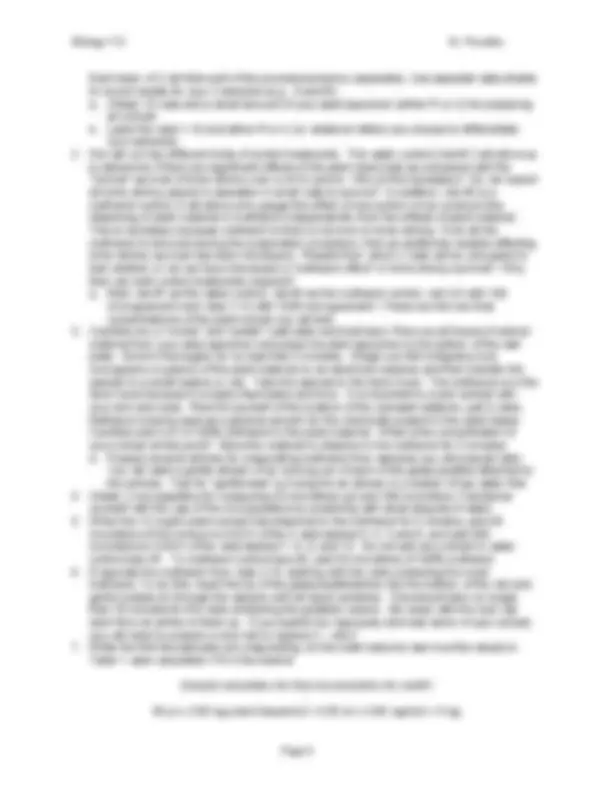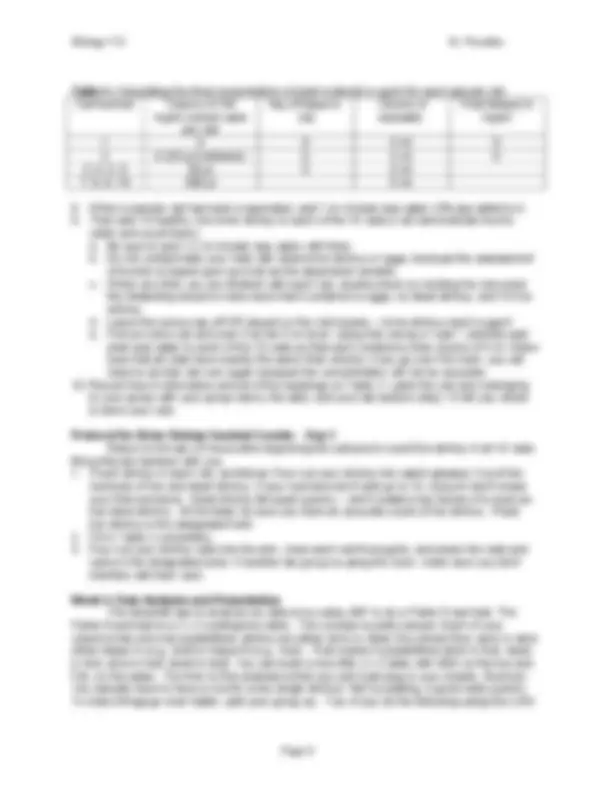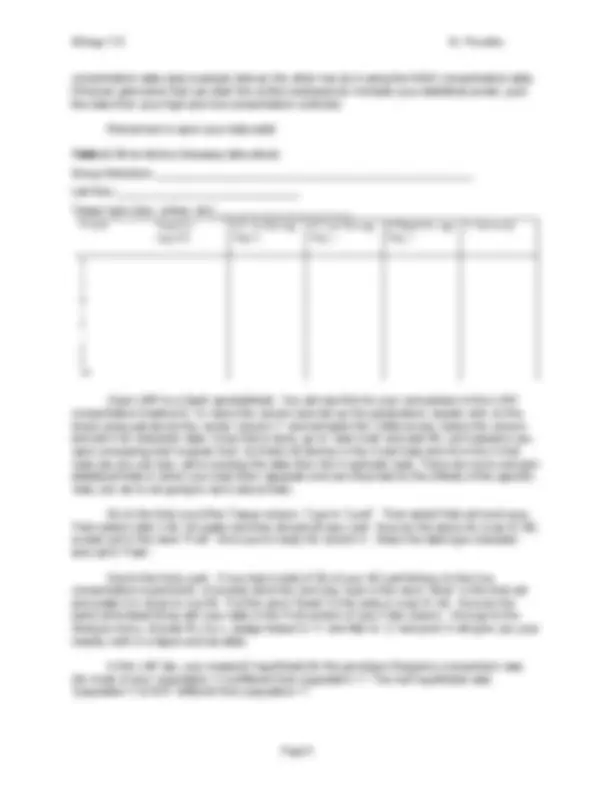





Study with the several resources on Docsity

Earn points by helping other students or get them with a premium plan


Prepare for your exams
Study with the several resources on Docsity

Earn points to download
Earn points by helping other students or get them with a premium plan
Community
Ask the community for help and clear up your study doubts
Discover the best universities in your country according to Docsity users
Free resources
Download our free guides on studying techniques, anxiety management strategies, and thesis advice from Docsity tutors
An exercise for biology 112 students to investigate the differential allocation of secondary compounds in plants as evidence by a bioassay. The role of secondary compounds as chemical signals, their functions as plant defenses against herbivores and pathogens, and the use of brine shrimp bioassays to screen for plant extracts with biological activity. Students will choose plant species, develop hypotheses, and test them using brine shrimp bioassays.
Typology: Lab Reports
1 / 7

This page cannot be seen from the preview
Don't miss anything!




Exericise 6: Plant Defenses: Investigating the Differential Allocation of Secondary Compounds Developed by Dr. Mark Stanback
Introduction The study of plant-animal interactions is an area of great interest in ecology, both from an evolutionary perspective and from a practical standpoint. For instance, the search for pharmaceuticals derived from chemicals found in vanishing plant species, and the use of biological control methods in efforts to improve agricultural productivity are both informed by plant-animal interaction studies. Because an investigation of plant-herbivore interactions uses knowledge and techniques from several sub-disciplines – ecology, biochemistry, evolution, physiology, plant morphology – it provides a model for the integrated nature of research. This lab will investigate the differential allocation of secondary compounds within individual plants as evidenced by a bioassay.
Objectives
Background All higher plants contain secondary substances: these are organic chemicals that have no known role in the metabolism of the plants in which they occur. Secondary substances have many different functions; of interest in this exercise is their role as chemical signals. Chemical signals act on different levels in the living world. Substances produced by one tissue that influence another tissue within the same organism are hormones. Those produced by one individual and influencing another individual of the same species are pheromones. Those active between different species are allelochemicals. For the purposes of this investigation, we will assume that the secondary compounds with which we will be working are allelochemicals, although some of these compounds may have evolved to serve a signaling function in the plant.
Allelochemic interactions are a major realm of adaptations that are normally invisible to us. Tannins, lignins, terpenes, alkaloids (such as caffeine and nicotine), strychnine, curare, and organic cyanides are just a few examples of the chemical arsenal that plants have evolved to defend themselves against herbivores and pathogens. Tannins, for instance, are sequestered in vacuoles in the leaves of oaks and other plants. Once consumed by an animal, they bind with leaf proteins and digestive enzymes in the gut, where they inhibit protein digestion. Thus, tannins considerably slow the growth of caterpillars and other herbivores. Ruffed grouse (Bonasa umbrellus) pay a significant cost to detoxify the coniferyl benzoate found in the flower buds of quaking aspen (Populus tremuloides); in addition, digestive efficiencies of grouse were reduced via dilution of utilizable nutrients by plant secondary metabolites (Guglielmo et al., 1996). Of course, herbivores may counter such toxic effects through adaptations of their own physiology and biochemistry (Tallamy, 1986). Herbivore species that evolve detoxification mechanisms may be able to specialize on plant hosts that are poisonous to most other species.
Plants have evolved some amazing defensive strategies. For example, there is evidence
that plant defenses may be induced by herbivore damage. That is, in response to wounds, toxic compounds may be produced – either in the area of the wound or systematically throughout the entire plant – that reduce subsequent herbivory (Jones et al., 1993). Of particular interest to us will be situations in which individual plants allocate chemical defenses differentially within their own tissues. For example, some plants maintain higher levels of secondary compounds in the high-nitrogen foliage preferred by herbivores (Newman et al., 1997). In the first week of this lab, we will walk around campus and discuss plant animal interactions, both mutualistic (pollination, seed dispersal) and antagonistic (herbivory/defense). After this introduction, you will choose plant species with which to work and develop hypotheses to test. In the second week, we will screen our samples using a “benchtop” bioassay, the brine shrimp bioassay (McGlaughlin, 1991). Brine shrimp (Artemia salina, Fig. 1) larvae have been used for over 30 years in toxicological studies. Researchers use brine shrimp as a pre-screen for plant extracts because they provide a quick, inexpensive, and desirable alternative to testing on larger animals. Brine shrimp bioassays effectively predict pesticide activities and respond to a broad range of chemically and pharmocologically diverse compounds (McGlaughlin, 1991).
Figure 1. Artemia salina, a brine shrimp. From http://biodidac.bio.uottawa.ca.
Bioassays are used for a variety of purposes – in general they allow researchers to screen for chemicals that show biological activity – that is, that show a biological effect (e.g., effects on survival, growth, or reproduction) on a selected species. For example, botanists and biochemists are currently using bioassays to screen unstudied plants for potentially useful, naturally occurring drugs. The US National Cancer Institute has also launched an intensive effort in “chemical prospecting,” especially in the tropics. This agency alone is screening some 10,000 substances/year for activity against cancer cells, HIV, and other diseases (Wilson, 1989). While it is unlikely that we will discover an unidentified cancer-fighting chemical in the plants investigated, it is important for us to keep in mind that the reason most of those chemicals exist in the first place is the result of coevolution between plants and herbivores. The more we know about “who” makes those chemicals, why they are made, how they are made, and the consequences of allelochemicals to both parties involved, the more we will know about the evolutionary process and about potential practical uses of such chemical evolutionary products for our own benefit.
Week 2 Protocol for Brine Shrimp Assay -- Day 0
Table 1. Calculating the final concentration of plant material in ug/ml for each sample vial. Vial Number Volume of 100 mg/ml extract used per vial
Mg of tissue in vial
Volume of seawater
Final [tissue] in mg/ml
1 0 0 5 ml 0 2 0 (50 μl methanol) 0 5 ml 0 3, 4, 5, 6 50 μl 5 5 ml 7, 8, 9, 10 500 μl 5 ml
Protocol for Brine Shrimp Survival Counts -- Day 1 Return to the lab 24 hours after beginning the cultures to count the shrimp in all 10 vials. Bring this lab handout with you.
Week 3: Data Analysis and Presentation The simplest way to analyze our data is by using JMP to do a Fisher Exact test. The Fisher Exact test is a 2 x 2 contingency table. The concept is pretty simple: Each of your columns has only two possibilities: shrimp are either alive or dead, the extract they were in were either tissue A (e.g., leaf) or tissue B (e.g., fruit). That means 4 possibilities (alive in fruit, dead in fruit, alive in leaf, dead in leaf). You can build a nice little 2 x 2 table with A&D on the top and F&L on the sides. The trick to this analysis is that you can’t just plug in your results. Bummer. You actually have to have a row for every single shrimp! But by pasting, it goes really quickly. To make things go even faster, split your group up. Two of you do the following using the LOW
concentration data (see example below); the other two do it using the HIGH concentration data. Whoever gets done first can start the control analyses (to increase your statistical power, pool the data from your high and low concentration controls).
Remember to save your data sets!
Table 2. Brine shrimp bioassay data sheet.
Group Members ____________________________________________________
Lab Day ______________________________
Tissue type (ripe, unripe, etc) ______________________
Open JMP to a blank spreadsheet. You will use this for your comparison in the LOW concentration treatment. To name the column and set up the parameters, double click on the empty area just above the words “column 1” and between the 2 little boxes. Name the column and set it for character data. Once this is done, go to “add rows” and add 80. Let’s assume you were comparing leaf vs green fruit. So that’s 40 shrimp in the 4 leaf vials and 40 in the 4 fruit vials (as you can see, we’re lumping the data from the 4 replicate vials. There are more complex statistical tests in which you keep them separate and can thus test for the effects of the specific vials, but we’re not going to worry about that).
Go to the first row of the Tissue column. Type in “Leaf”. Then select that cell and copy. Then select cells 2-40. Hit paste and they should all say Leaf. Now do the same for rows 41-80, except put in the word “Fruit”. Now you’re ready for column 2. Make the data type character and call it “Fate”.
Here’s the tricky part. If you had a total of 30 of your 40 Leaf shrimp (in the low concentration experiment, of course) alive the next day, type in the word “Alive” in the first cell and paste it in down to row 30. Put the word “Dead” in the cells in rows 31-40. Now do the same alive/dead thing with your data in the Fruit portion of your Fate column. Now go to the Analyze menu, choose fit y by x, assign tissue to “x” and fate to “y” and poof, it will give you your results, both in a figure and as stats.
In the LAP lab, your research hypothesis for the genotype frequency comparison was (for most of you) “population X is different from population Y.” The null hypothesis was “population X is NOT different from population Y.”
Assignment We will analyze the results and prepare a presentation in laboratory during the analysis week of this exercise. Your group must work efficiently and divide up the labor to finish the presentation before the third hour of lab begins. Some members of the group will focus on analysis and construction of graphs, while others will focus on background research (library and internet) on the plant you’ve chosen to analyze. Consider the following questions, but do not limit your discussion to these topics: 1) What is the relationship between the concentration of plant extract and percent shrimp survival (if any) and what is the biological significance of this? 2) Even if the data support your hypothesis, is your hypothesis the ONLY explanation for what you found, or are there still other possibilities? If so, what are they? 3) If producing anti-herbivore chemicals is beneficial to plants, then why don't all plants produce lots of them all the time? You will receive a group grade for the preparation and presentation of these results.
References Bruin J, Sabelis MW, & Dicke M (1995) Do plants tap SOS signals from their infested neighbors? Trends in Ecology and Evolution 10:167-170. Guglielmo CG, Karasov WH, & Jakubas WJ (1996) Nutritional costs of a plant secondary metabolite explain selective foraging by ruffed grouse. Ecology 77:1103-1115. Jones CG, Hopper RF, Coleman JS, & Krischik VA (1993) Control of systemically induced herbivore resistance by plant vascular architecture. Oecologia 93:452-456. McGlaughlin JL (1991) Bench-top bioassays for the discovery of bioactive compounds in higher plants. Brenesia 34:1-14. Newman RM, Kerfoot WC, & Hanscom Z (1997) Watercress allelochemical defends high- nitrogen foliage against consumption: effects on freshwater invertebrate herbivores. Ecology 77:2312-2323. Tallamy DW (1986) Behavioral adaptations in insects to plant allelochemicals. In: Molecular aspects of insect-plant associations (Brattsen LB & Ahmad S, eds). Plenum Press, New York, pp. 273-300. Wilson EO (1989) Threats to biodiversity. Scientific American 261:108-116.
This lab investigation was developed for use at Davidson College by Dr. Mark Stanback. It was adapted from: Winnett-Murray K, Hertel L, & Murray KG (1997) Herbivory and anti-herbivory: investigating the relationship between the toxicity of plant chemical extracts and insect damage to the leaves. In: Tested Studies for Laboratory Teaching (Glase J, ed). Association for Biology Laboratory Education 18: 249-268.